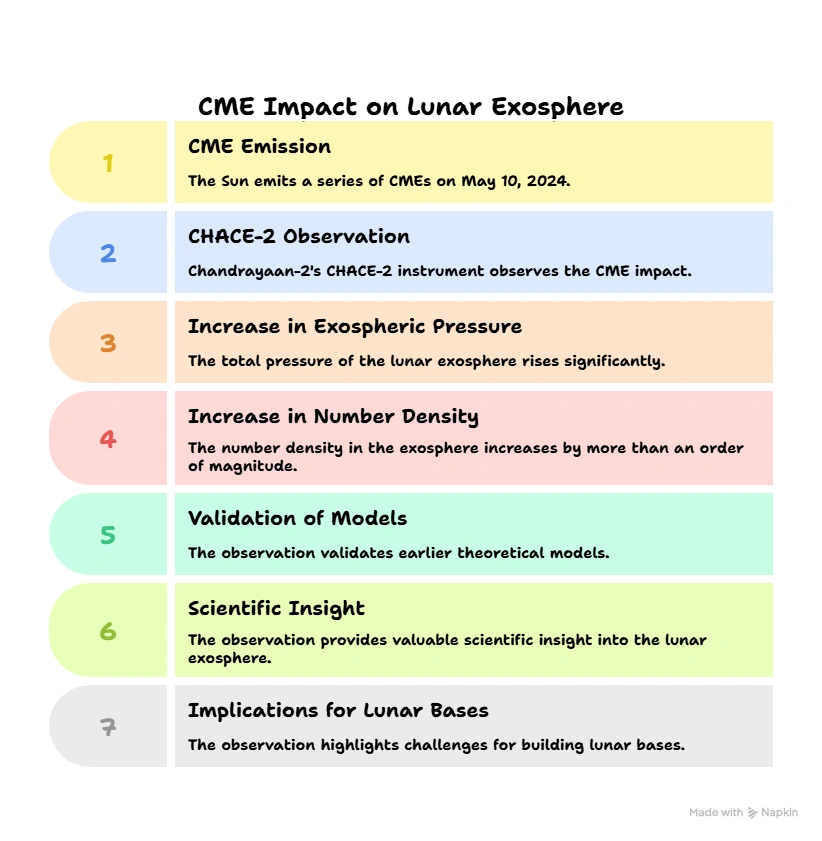Paper: GS – III, Subject: Science and Technology, Topic: Space Technology, Issue: CHACE-2 payload.
Context:
ISRO’s Chandrayaan-2 mission, through its CHACE-2 payload, has made the first-ever observation of a solar coronal mass ejection’s impact on the Moon’s exosphere.
Key Takeaways:
About Chandra’s Atmospheric Composition Explorer-2 (CHACE-2) Payload: What it is?
- CHACE-2 is a neutral gas mass spectrometer payload onboard the Chandrayaan-2 orbiter, developed by ISRO to study the composition and dynamics of the Moon’s extremely thin atmosphere, known as the lunar exosphere.
- Launched in: The payload was launched on July 22, 2019, as part of India’s Chandrayaan-2 mission aboard the GSLV Mk-III M1 rocket.
Aim:
- Its primary goal is to analyze the chemical composition, spatial and temporal variations, and density of the lunar exosphere in the mass range of 1–300 amu, along with detecting water vapour and heavier molecules to understand lunar surface–exosphere interactions.
Key Features:
- Successor to CHACE (Chandrayaan-1) and MENCA (Mars Orbiter Mission) instruments.
- Equipped to measure neutral gases and isotopic abundances on the Moon.
- Provides real-time in situ data on exosphere composition and variations.
- Designed to detect noble gases like Argon-40, and study their spatial distribution.
- Helps in modeling lunar surface processes and space weather influences.
Discoveries Made Now:
Context:
ISRO’s Chandrayaan-2 mission, through its CHACE-2 payload, has made the first-ever observation of a solar coronal mass ejection’s impact on the Moon’s exosphere.
Key Takeaways:
About Chandra’s Atmospheric Composition Explorer-2 (CHACE-2) Payload: What it is?
- CHACE-2 is a neutral gas mass spectrometer payload onboard the Chandrayaan-2 orbiter, developed by ISRO to study the composition and dynamics of the Moon’s extremely thin atmosphere, known as the lunar exosphere.
- Launched in: The payload was launched on July 22, 2019, as part of India’s Chandrayaan-2 mission aboard the GSLV Mk-III M1 rocket.
Aim:
- Its primary goal is to analyze the chemical composition, spatial and temporal variations, and density of the lunar exosphere in the mass range of 1–300 amu, along with detecting water vapour and heavier molecules to understand lunar surface–exosphere interactions.
Key Features:
- Successor to CHACE (Chandrayaan-1) and MENCA (Mars Orbiter Mission) instruments.
- Equipped to measure neutral gases and isotopic abundances on the Moon.
- Provides real-time in situ data on exosphere composition and variations.
- Designed to detect noble gases like Argon-40, and study their spatial distribution.
- Helps in modeling lunar surface processes and space weather influences.

Discoveries Made Now:
- Recorded the first-ever evidence of a CME-induced rise in lunar exosphere pressure on May 10, 2024, when solar ejecta struck the Moon.
- Observed a tenfold increase in total number density of neutral atoms, confirming long-predicted theoretical models.
- Provided insights into how solar activity alters lunar atmospheric conditions, crucial for future lunar base planning and space weather prediction.
La Excellence IAS Academy, the best IAS coaching in Hyderabad, known for delivering quality content and conceptual clarity for UPSC 2025 preparation.
FOLLOW US ON:
◉ YouTube : https://www.youtube.com/@CivilsPrepTeam
◉ Facebook: https://www.facebook.com/LaExcellenceIAS
◉ Instagram: https://www.instagram.com/laexcellenceiasacademy/
GET IN TOUCH:
Contact us at info@laex.in, https://laex.in/contact-us/
or Call us @ +91 9052 29 2929, +91 9052 99 2929, +91 9154 24 2140
OUR BRANCHES:
Head Office: H No: 1-10-225A, Beside AEVA Fertility Center, Ashok Nagar Extension, VV Giri Nagar, Ashok Nagar, Hyderabad, 500020
Madhapur: Flat no: 301, survey no 58-60, Guttala begumpet Madhapur metro pillar: 1524, Rangareddy Hyderabad, Telangana 500081
Bangalore: Plot No: 99, 2nd floor, 80 Feet Road, Beside Poorvika Mobiles, Chandra Layout, Attiguppe, Near Vijaya Nagara, Bengaluru, 560040

